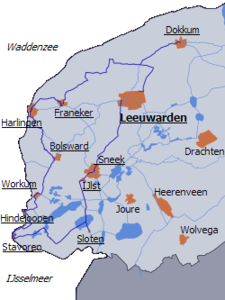The tour, almost 200 km in length, is conducted on frozen canals, rivers and lakes between the eleven historic Frisian cities: Leeuwarden, Sneek, IJlst, Sloten, Stavoren, Hindeloopen, Workum, Bolsward, Harlingen, Franeker, Dokkum then returning to Leeuwarden.
 The tour is not held every year, mostly because not every Dutch winter permits skating on natural ice. The last editions were in 1985, 1986 and 1997. Adding to that, the tour currently features about 15,000 amateur skaters taking part, putting high requirements on the quality of the ice. There is a stated regulatory requirement for the race to take place that the ice must be (and remain at) a minimum thickness of 15 centimeters along the entirety of the course.
The tour is not held every year, mostly because not every Dutch winter permits skating on natural ice. The last editions were in 1985, 1986 and 1997. Adding to that, the tour currently features about 15,000 amateur skaters taking part, putting high requirements on the quality of the ice. There is a stated regulatory requirement for the race to take place that the ice must be (and remain at) a minimum thickness of 15 centimeters along the entirety of the course. All skaters must be a member of the Association of the Eleven Frisian Cities.
A starting permit is required. Furthermore, in each city the skater must collect a stamp, as well as a stamp from the three secret check points. The skater must finish before midnight.
The finishing point of the Elfstedentocht is a canal near Leeuwarden, called the "Bonkevaart".

Since the Elfstedentocht is such a rare event, its declaration creates excitement all over the country. As soon as a few days pass with sub-zero temperatures, the media start speculating about the chances for an Elfstedentocht.
The longer the freezing temperatures stay, the more intense this "Elfstedenkoorts" (eleven cities tour fever) gets - culminating in a national near-frenzy when it is announced that the tour is actually taking place.
On the day of the race most Frisians and Dutchmen either stay home to watch the race on television or find a place along the route to cheer on the skaters.

History
The winters of 1939/40, 1940/41 and 1941/42 were particularly severe, with the race being run in each of these winters. The 1940 race, run three months prior to the entry of The Netherlands to World War II, saw over 3,000 competitors start at 05:00 on 30 January, with the first five finishing at 16:34. The event dominated the front pages of Dutch newspapers.
The Elfstedentocht of 1963 is known as "The hell of '63" when only 69 of the 10.000 contestants were able to finish the race, due to the extremely low temperatures -18°C and a harsh eastern wind. Conditions were so horrendous that the winner of '63, Reinier Paping, became a national hero, and the tour itself legendary.
After '63, the next Elfstedentocht did not take place until 1985, over 20 years later. Times had changed. In 1963 and before, one of the best methods to stay warm during the tour was to put newspapers underneath the clothes. During the 20 years between the tours of '63 and '85, clothing, training methods and skates became much more advanced, changing the nature of skating forever.
The last tours were in 1985, 1986 and 1997.
Last week the Netherlands was again in the ban of the Elfstedentocht fever.
All the News was dominated with the minimum thickness.
Last evening the organizing Committee say there will be no Elfstedentocht in the next weeks as there are expecting the melting of the ice.
The end for a national fever.....for this moment.
Geen opmerkingen:
Een reactie posten